Hôtel de Lauzun
| Hôtel de Lauzun | |
|---|---|
|
The north facade, facing the quai d'Anjou and the Seine | |
| General information | |
| Architectural style | Classicism |
| Address | 17, quai d'Anjou |
| Town or city | Paris |
| Country | France |
| Construction started | 1657 |
| Completed | 1658 |
| Design and construction | |
| Architect | Charles Chamois |
The Hôtel de Lauzun is a 17th-century hôtel particulier, or private mansion, located on the quai d'Anjou of the île Saint-Louis in the 4th arrondissement of Paris, France. It is among the few parisians hôtels that retain their rich carved, painted, mirrored and gilded interiors from the time of Louis XIV.[1]
History
The hôtel particulier was not built by the Duc de Lauzun whose name it bears, but by a wealthy financier, Charles Gruyn des Bordes,[2] the son of an inn-keeper grown rich from his trade and richer still, according to a pamphleteer,[3] through speculations enabled by his title as general commissioner of cavalry during the civil disorders of the Fronde.
Gruyn des Bordes had purchased the lot in 1641, but by the time he was prepared to build, he had new neighbours in the Île Saint-Louis to emulate, namely, the Hôtel Lambert de Thorigny. His new wife, Geneviève de Mony, hastened the completion of the house, completed in 1657 or 1658. The architect was Charles Chamois.[4]
Gruyn's initial 'G' is interlaced with her 'M' on chimneybreasts and throughout the decor. Gruyn, however, had Nicolas Fouquet as a patron and shared in Fouquet's disastrous fall. An inquest into his financial dealings found him guilty of fraud; he was thrown into prison and died there. His widow, having kept her financial affairs separate from his, survived his ruin and left the hotel to her son.
In the meantime, Antoine Nompar de Caumont, Duc de Lauzun, had fallen from Louis XIV's favour and had spent a decade in prison. Once he had clandestinely wed his lover, La Grande Mademoiselle, she had ransomed him from the King and he immediately purchased the estate from de Mony's son. Lauzun enriched many of the interiors. The Hôtel de Lauzun passed on to the great-niece of Cardinal Mazarin, who fled from the convent of Chaillot with the Marquis de Richelieu and eloped him in London. In 1709 the Marquis de Richelieu sold the house to Pierre-François Ogier, receveur du clergé who further enriched its interiors.
In the 18th century, the hôtel de Lauzun retained its aristocratic owners (now the Marquis de Pimôdan) until the French Revolution. With that event, the estate, like many of its once-grand neighbours, had its upstairs chambers and attics divided into apartments and rented by successful artisans. In the 1840s, when the estate (now known as Hôtel Pimodan) belonged to the bibliophile and collector, baron Jérôme Pichon, auditeur au Conseil d'État, the upstairs apartments were rented to Charles Baudelaire (in 1843, for 350 francs[5]) and Théophile Gautier. These two residents formed their Club des Hashischins, where they experimented with hashish. While residing there, Baudelaire wrote the first poems of Les Fleurs du Mal.
The hôtel de Lauzun, protected as an heritage site in 1906 and owned by the City of Paris since 1928, houses since 2013 the Institut d'études avancées de Paris, a research institute in social science, which hosts symposiums or conferences in the building.[6]
Description
The building does not fit the most traditional layout of an hôtel particulier, which usually features a main building entre cour et jardin, separated from the street on the front by a courtyard, and facing a private garden on the back.[7] Fitting the exceptional location of the lot, facing the Seine, Charles Chamois chose to place the main building on the front, and to raise the ground floor to protect it and ensure an enjoyable view of the river.[8] The high foundations serve as a service space. A richly ornamented balcony extend the main room on the street facade.The courtyard forms the back of the hôtel, which does not feature a garden.
- Main portal, with the name and completion date of the hôtel engraved above
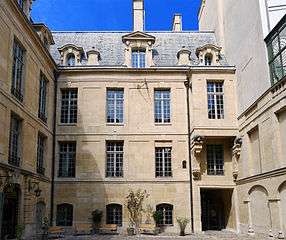 Courtyard and north facade
Courtyard and north facade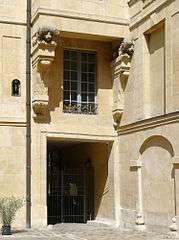 Detail of the north courtyard facade : lion sculptures supporting a small cabinet
Detail of the north courtyard facade : lion sculptures supporting a small cabinet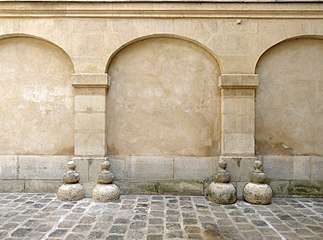 Blind east wall in the courtyard
Blind east wall in the courtyard.jpg) Main facade, on the street
Main facade, on the street Courtyard door
Courtyard door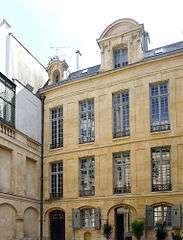 South courtyard facade
South courtyard facade
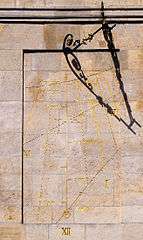 Sundial in the courtyard
Sundial in the courtyard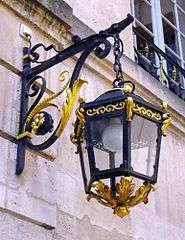 Carved and glided lantern on the street facade
Carved and glided lantern on the street facade Carved and ornamented 17th century gutter
Carved and ornamented 17th century gutter
The hôtel is renowned for its richly decorated interiors, which are among the only ones preserved from the 17th century in Paris. Typical of interiors decoration during the early reign of Louis XIV, it features heavily gilded wall sculptures, and paintings by Michel Dorigny. The main room, or grande chambre, was converted in 1907 into a music salon, topped by a rostrum.
Notes
- ↑ http://www.culture.gouv.fr/public/mistral/merimee_fr?ACTION=CHERCHER&FIELD_1=REF&VALUE_1=PA00086297
- ↑ His name, "des Bordes," derived from land he possessed in Noizières, near Lagny (Fournier 1864).
- ↑ "Les Gruyn, frères et fils du maistre du cabaret de la Pomme de Pin, à force de pillages, qu'ils ont faits dans la subsistance, lors de l'établissement d'icelle, ont acquis de grands biens et possèdent des charges de finances très considérables." quoted by Fournier 1864).
- ↑ Alexandre Gady, Les hôtels particuliers de Paris, du Moyen-Âge à la Belle époque, Paris, Parigramme, 2008, p. 196.
- ↑ Adolphe Tabarant, La Vie artistique au temps de Baudelaire (Paris: 1943), p. 75
- ↑ Kolk, Caroline zum. "L'hôtel de Lauzun – Institut d'études avancées de Paris". www.paris-iea.fr (in French). Retrieved 2017-12-01.
- ↑ Alexandre Gady, Les hôtels particuliers de Paris, du Moyen-Âge à la Belle époque, Paris, Parigramme, 2008, p.56
- ↑ Ibid. p.59-60.
Bibliography
- Boulhares, Raymond and Soleranski, Marc (2015) L'hôtel de Lauzun : trésor de l'île Saint-Louis, Paris, Artélia, 2015
- Gady, Alexandre (2008), Les hôtels particuliers de Paris, du Moyen-Âge à la Belle époque, Paris, Parigramme, 2008.
External links
| Wikimedia Commons has media related to Hôtel de Lauzun. |